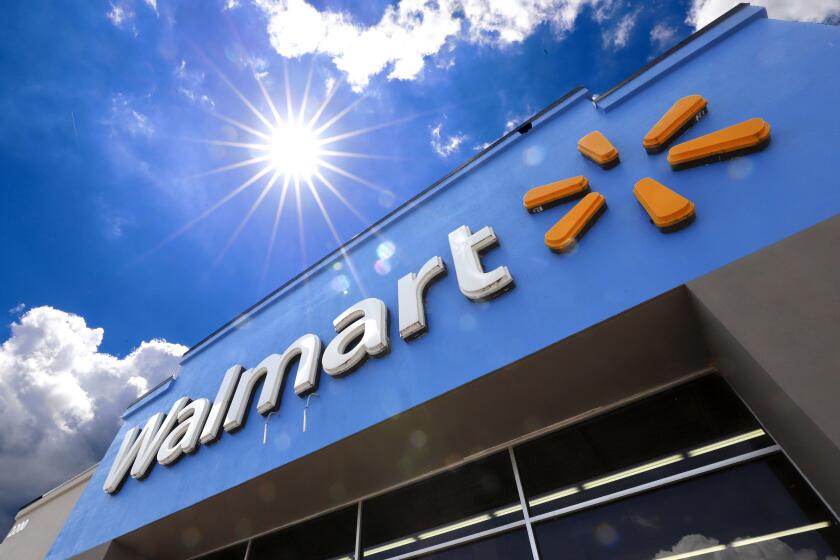Retailers Find Sales Registering With Season’s Bargain Hunters
- Share via
Shoppers packed Southern California stores and malls on Friday, especially those that slashed prices on popular electronics, boosting retailers’ hopes for a profitable holiday season.
About 2,000 people ringed the Best Buy store at Lakewood Center, waiting for the 5 a.m. opening. At the same time, nearly 1,000 were gathering outside Wal-Mart in Baldwin Hills Crenshaw Plaza, where video games were selling for $8 and DVD players for $68.
Shopping on the day after Thanksgiving is a 13-year tradition for Genise Brown, who was especially enthusiastic about Best Buy’s “buy one, get one free” sale on portable DVD players. Her marching orders for the rest of the day were in the car -- a stack of ads from Old Navy, Mervyn’s, Target, Kohl’s and Macy’s.
“I’m going to spend my money,” said Brown, 35, a teacher who lives in Signal Hill.
Across the country, merchants reported that day-after-Thanksgiving traffic was at least as strong as last year, when the day’s sales jumped an estimated 11% from the previous year.
That was sure to buoy many retailers, which were unsure what to expect. Initially, industry analysts and economists said this holiday season would be one of the most difficult to predict. They feared that higher gasoline prices, home heating bills, rising interest rates and an outpouring of charitable giving after a season of devastating hurricanes might have left consumers tapped out.
“There’s no historical model, no paradigm, that matches this time,” said Eli Portnoy, a retail strategist with Portnoy Group Inc. in Los Angeles. “I think this is a wild-card season.”
But a new batch of data in recent weeks, including strong retail sales at the end of October, had encouraged some experts to be more optimistic with their projections.
In perhaps the best news, gas prices have dropped dramatically nationwide from the $3-plus-a-gallon stratosphere, where they shot in early September after Hurricane Katrina.
Still, prices remain about 12% higher than a year earlier. And months of expensive gas have drained more than $90 billion from Americans’ pockets this year, according to Merrill Lynch & Co., using its rule of thumb that every penny increase at the pump reduces household cash flow by $1.5 billion.
Then there are the utility bills that will be tucked next to holiday catalogs in consumers’ mailboxes and are expected to grow ever larger as temperatures fall.
George Gonzalez and his wife, Rosario, commiserated about gasoline prices even as they drove Friday morning from their home in Anaheim to Fashion Island in Newport Beach looking for basics on sale, such as T-shirts and pajamas.
“We have been spending more on gas and rents and everything,” said George, a 41-year-old machine operator. Their rent has jumped twice in the last two years even as Rosario’s work hours have been cut to part time. So they will spend less this year on the holidays, he said.
For all the mixed signals leading up to Friday, the National Retail Federation, the industry’s largest trade group, raised its holiday projection last week, saying it expected sales to rise 6% this season to $439.5 billion. That’s up from a previously projected 5% and closer to last year’s strong 6.7% gain.
The group said Friday that early feedback from its members indicated that sales this holiday weekend might surpass the $22.8 billion that shoppers shelled out last year. Formal sales estimates will be released this weekend.
Also Friday, Thomson Financial said it expected sales at stores open a year or more to rise a strong 4.1% in November, compared with 1.6% last year. Solid retail trends and an anticipated 39% jump in online sales were key to the increase, said senior research analyst Jharonne Martis, who noted that she was at Circuit City in Union Square in New York when the crowd swelled to the point that police were summoned.
And investors were clearly cheered by what they saw. Best Buy headed the winners list, its shares gaining 3.3% in abbreviated trading. Shares of Circuit City Stores Inc., Tiffany & Co., Limited Brands Inc. and Nordstrom Inc. also rose. A Morgan Stanley index of 35 national retailers hit its highest level since mid-August.
Among the encouraging signs for retailers were October’s better-than-expected sales. Retail sales, excluding autos, rose 0.9% last month from a year earlier, handily beating economists’ expectations of a 0.3% gain, according to the Commerce Department.
“If the trends remain solid, we may be talking a much better holiday season than largely feared,” said Michael Niemira, chief economist for the International Council of Shopping Centers.
“Fear” being the operative word, many retailers slashed prices more aggressively this year, industry experts say. Early markdowns can cut into sellers’ profits, but they also mean that shoppers may grab that leather jacket or liquid crystal display television before they “see their heating bills and freak out,” said Steve Baker, vice president of industry analysis for NPD Group.
Consumers definitely are looking for bargains. A poll by America’s Research Group found that shoppers want discounts of 40% to 60%.
“They’re getting greedy,” said Britt Beemer, the group’s chairman. “Retailers need to understand this is the most promotional-minded shopper in the last five Christmas shopping seasons.”
One thing is certain: Americans have proved they can shop and worry simultaneously.
“They’ll grumble when they fill their SUVs, but they’ll keep spending,” said Edward Leamer, director of UCLA’s Anderson Forecast.
Brandie White, 26, of Hawthorne said that her Chevy Tahoe guzzled gas “big time” but that she planned to spend more this year anyway. The early-bird specials at Target in Lakewood presented a perfect opportunity.
“You can’t get these deals year-round, so you might as well come out early,” said White, a human resources manager.
Despite all the hoopla Friday, holiday shopping actually starts quietly, months earlier. The season has been extended by the growing popularity of gift cards, which experts say will be in more hands than ever this year. Often, cardholders don’t wield them until January or later -- and retailers can’t log them as sales until they are redeemed.
In any case, consumer spending represents about two-thirds of the U.S. economy. And for retailers, November and December remain key months.
Last year, 20% of the industry’s annual sales were collected during the holiday shopping season, according to the National Retail Federation. But some retailers haul in as much as 40% of their revenue in that period.
At Macy’s in downtown Los Angeles, Alicia Dutirrez was helping them out, if cautiously.
The 38-year-old L.A. resident and her three daughters woke up at 5:30 a.m. to catch an early bus downtown. That saved the family gas money, said her daughter Yessenia, 18, but not enough to buy the presents they can usually afford.
“We’re buying the same number of presents -- but cheaper ones,” said Yessenia, toting a pair of shoes and a bag full of sweaters. “Instead of a $30 shirt, I’ll get a $20 shirt.”
The season is especially important for companies that sell toys, such as the Disney Store chain, which was acquired a year ago by Children’s Place Retail Stores Inc. The chain opened some of its stores at 1 a.m. Friday, a first for Disney Store, and started its weekend promotions Wednesday.
The retailer expanded its toy section, added more clothing and stocked up on items that it hopes will be big sellers, including dolls and action figures tied to Disney movies.
“We have greatly increased our inventory to take advantage of what we think will be a great holiday,” said Mario Ciampi, president of Disney Store, which operates 47 California locations.
Kattya Cole, 27, was one of the first 50 customers in line outside Disney Store in Lakewood. Some had arrived two hours before the 4 a.m. opening. Cole, a regular at Disney’s after-Thanksgiving sales, arrived at 3:30 a.m., unfazed about having to report to work at 7.
The Downey resident bought 12 Disney Princess Toddler dolls -- $9.99 each, with an additional 20% off -- for her 1- and 3-year-old daughters and a niece in Bolivia who calls her “Tia Santa.”
Still, she said, “I did spend a little bit less, just because of gas.”
Charitable groups also have been vying for Americans’ attention this year. The Red Cross alone has received a total of $1.52 billion in monetary gifts and pledges for hurricane relief. The hurricane giving continues even as charitable groups are mailing out the usual seasonal appeals for donations.
Manhattan Beach resident Rona Titut, 41, who draws maps for the government, said she contributed about $2,500 to charities this year. “I’m trying to spend less, partly because we donated money to Hurricane Katrina victims,” Titut said.
She eyed a $915 Prada purse on Rodeo Drive in Beverly Hills but decided against it, saying she had recently bought the Louis Vuitton handbag she was carrying.
Friday was both grueling and fruitful for one group of six buddies who got to Best Buy in Costa Mesa at 2 a.m. with hopes of buying cameras, CDs and printers, only to find that they had to get to the end of a line that had started forming the afternoon before.
“People were fighting -- verbally and physically fighting -- because people cut in line,” said Don Do, 19, of Garden Grove.
After scouring nearby South Coast Plaza, including stops at Macy’s and Express, they took a break.
“All we did was buy this one shirt and they gave us this for free,” said Do’s pal David Nhan, 20, pulling a red scarf and beanie from an Express bag. “Good deal.”
Times staff writers Cynthia H. Cho, Lynn Doan and Arin Gencer contributed to this report.
More to Read
Inside the business of entertainment
The Wide Shot brings you news, analysis and insights on everything from streaming wars to production — and what it all means for the future.
You may occasionally receive promotional content from the Los Angeles Times.










